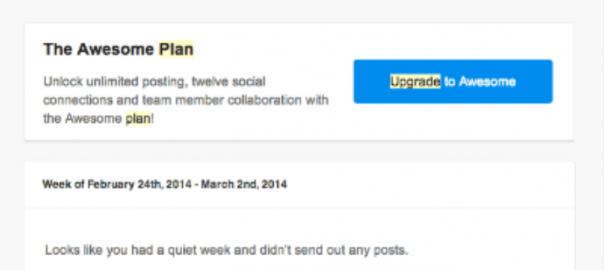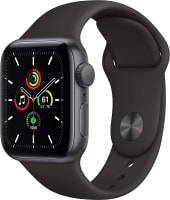
We recently introduced how drip email campaigns can have a profound effect on the growth of your business.
For most online businesses, email marketing plays a large role in the process of acquiring new leads, converting warm leads, and retargeting existing leads and current customers.
The company in the spotlight today is Buffer, a leading social media app. They use drip email campaigns as a great lead nurturing tactic.
Buffer’s emails don’t typically include a hard sell which can be very effective given the email saturation of the modern world. Their email campaigns work to convert and retain customers through nurturing, soft selling and “zero selling.”
On average, their email course campaigns convert at 2.8% and some even as high as 7-9%!
Let’s look at how Buffer uses drip campaigns in their email marketing plan to further their brand message and customer base.
An Introduction to Buffer

Buffer allows you to automate posting on a number of social media platforms.
The app was launched in November 2010 and is the brainchild of Joel Gascoigne who developed it after being frustrated with the complicated scheduling tools available at the time.
Originally, the application was only available for Twitter but now you can schedule posts on Facebook, LinkedIn, Google+, Instagram and Pinterest.
In just 3 short years Buffer grew from nothing to 1 million users, $ 2 million revenue and 13 employees.
As of October 2016, the site has over 63,000 paying customers and revenue of $ 12.36 million.
Defining Moments
Buffer grew dramatically in the beginning through a range of innovative digital marketing methods. They used aggressive content marketing, which wasn’t as popular a tactic then as it is now, and clever growth hacks skillfully supported by mailing campaigns.
Leo Widrich, co-founder of Buffer, stated that they gained 100,000 users from guest blogging in the first 9 months.
Buffer also purchased Digg Digg, a floating social share bar WordPress plugin once it reached 300,000 downloads. They added a Buffer share button and then put it back out for free download, spreading awareness of their platform even further.
Kevan Lee, the company’s Director of Marketing recently commented on email marketing saying, “We’ve enjoyed focusing on email marketing as a way to communicate with our users, and we’ve noticed a few different ways this looks for us from the marketing side: information sharing (like announcements and launches), surprise and delight (campaigns that celebrate user success and milestones), and education.”
Today, Buffer uses email campaigns for a variety of functions including customer onboarding and even email-based courses, with great success. Their first email course campaign ran through MailChimp and had a 39% open rate. 10% of readers signed up to their main mailing list.
Drip Campaign Email Examples
Let’s take a look at some of the campaigns and emails Buffer uses.
Onboarding Campaign
Onboarding campaigns are one of the most important drip campaigns when it comes to the success of your business. A great example of an onboarding campaign is one that takes a potential customer who has signed up for a free trial of your product and turns them into an actual paying customer.
Buffer’s campaign is very effective at doing this. Here are some of the stages of their onboarding email campaign:
Welcome Email
Welcome emails are the most important message of an onboarding campaign. This is where you create the first impression of your business. Welcome emails are one of the most opened emails in email marketing and the postscript is one of the most read parts of an email message. Groove describes the text you put in the P.S. section as “prime real estate” for making a strong impact.

Pros:
- The key to effective onboarding or lead nurturing is to write your emails like you’re having a conversation. Inside Intercom writes, “We believe in the value of personal conversations between businesses and customers. We believe the future of customer communications will be much more like the chats you have with friends, and much less like tickets, applications and transactions that you formally submit to siloed departments.”
- There’s also been a study into the psychology of the message you give out when talking, known as the 7-38-55 rule. 7% of what you say is communicated by the words you use, 38% by tone of voice and 55% by body language. Since you can’t show body language in an email, you must rely on your word choice to convey the right meaning. Buffer has perfected a friendly, conversational tone in this email. Checking that, “everything is in place” for the reader to “feel at home” – and using informal language such as “whim” and “gist.”
- Groove praises Buffer for addressing the elephant in the room that this message isn’t sent personally, even though it’s made to look like it is. Most people are aware of this these days. By adding the “P.S. We’re always around and love hearing from you. Please get in touch if you want to ask something or even just to say hello :)” they give a nod to this while giving great customer service by letting the reader know that they can talk to someone personally if they wish.
- The success of your welcome email is dependent on having a clear call to action. If users are unsure what they are clicking on, all your efforts to craft the perfect email are wasted. It’s clear that clicking on the call to action in the email will download the Buffer browser extension – and the button stands out boldly on the page. It also enhances customer satisfaction by offering an additional helpful feature to users.
Cons:
- Knowtify’s only critique is that an image would give the reader a visual break from the chunks of text. But the jury is out on this one as Marketing Land says, “don’t be afraid to send plain text emails. It forces you to focus on the quality of the content rather than the design.” We suggest mixing it up, do some testing, and see what happens with your results.
- The personal touch in this email could be enhanced by linking to a more personal sounding email address for help as “hello@bufferapp.com” or something similar. In the early days, CEO Joel Gascoigne said he was “in touch on my personal email address with almost everyone who signed up for Buffer. With low volume, I could always respond immediately and people loved it.”
Article Suggestions
In the early stages of onboarding you shouldn’t push your product on subscribers, but instead start to build a relationship. Sendwithus hit the nail on the head when they said, “onboarding emails should focus on educating users, not pitching them.”
Buffer is well known for their friendly and helpful communication style and have recently tried a “zero sell” mindset for their email campaigns.
Buffer follows up their welcome email with a reading suggestion on Twitter Hacks:

Pros:
- This message is short and to the point, if you aren’t interested you will know from reading the title and can delete accordingly.
- The tone of the text is relaxed, more like a friend that is doing you a favor than a business trying to sell.
- Most importantly, the email simply adds value to the reader – there is no hidden intention, no upselling or sign ups.
- Again, the call to action is clear.
Cons:
- One criticism is that the top sentences may be seen as pushy. The reader is encouraged to post because 2,766,274 other users have. But since it’s pushing towards using the service and not parting with more dollars, Buffer is able to pull it off.
Reconnection Email
The final email in this set is triggered if users don’t use Buffer for an extended period of time. The message gently encourages the reader to give Buffer a chance.

Pros:
- Buffer continues in a conversational manner, speaking as if the reader is a friend, by this point in this series the reader should be getting used to this tone as their relationship with the company builds.
- The message gently encourages the reader to give Buffer a chance. Shoving their service in their reader’s face is likely to have the opposite effect.
- The message offers awesome customer service saying, “I’d love to see if there’s anything we can do to help” and offering advice on using Buffer’s features find content that, “really resonates with your fans.” Not only does this contribute to the onboarding process but also aligns with Buffer’s company values of outstanding customer service. They have a whole department known as the Community Delight Headquarters. Nicole Miller, Community Champion at Buffer, said, “Our customers are the true heart of all we do here at Buffer — and we want to make sure the community knows it.”
- The call to action button is clear because it takes you straight to the Buffer Dashboard in one step. As Sendwithus says, onboarding emails should, “remove as much friction as possible” for users. The easier you can make it for them to use your product the better.
Cons:
- Again, an extra personal touch could have been added by including the recipient’s name in the body of the message.
- Even though it’s done in a tasteful manner, this message may still be too pushy for some readers. Sending more educational and informative emails first could help to deal with this.
Re-engagement Campaign
Drip emails are a great way to encourage reengagement for people who don’t use your product as often as they could – or have stopped using it altogether. Monitoring their click through rate can also tell you a lot about how your product is being received.
VWO recommends having multiple trigger points for sending reengagement emails – for example at three months, six months and at one year – but you must monitor interaction to determine the best frequency for your audience.
Below is a reengagement email sent by Buffer:

Pros:
- Comparing your usage to the 2,844,500 other posts produced through Buffer is a clever move. It employs the social proof principle that is very effective in digital marketing today. Seeing that many of your peers are using the application is a strong influence to do the same.
- Linking to easier ways to use Buffer increases “customer delight” and the reader’s overall view of the company.
Cons:
- This email is very busy. It has three links and two calls to action. The calls to action may be off-putting because they are not actually related to the content of the message – they are purely upselling.
Referral Emails
Referral emails are a great email to add to any campaign at a point when you know that the reader is happy with your service. SuperOffice advocates sending one of these emails to customers who didn’t sign up so that you can continue the conversation and get feedback on where you went wrong.
Below is one of Buffer’s referral emails:

Pros:
- The tone is conversational and very thankful. You get the feeling that Buffer really does care about you as a customer.
- The call to action couldn’t be clearer, and there is only one with no other links or upsells in the message to distract.
Cons:
- There really aren’t any faults in this message. Some people will be turned off by being asked to go out of their way to do something, but Buffer can get away with it from the language they use.
Compare and Contrast: Hootsuite
One of Buffer’s main competitors in social media scheduling is Hootsuite. Let’s take a look at some of their emails and compare it to some we have already seen from Buffer.
Welcome Email

Buffer’s welcome email:

Pros:
- Hootsuite is adding value right off the bat by offering the user the chance to sign up for an educational webinar. This adds much more value to the user than a browser extension.
- Their call to action is clear and encourages readers to act “now.” This small word gives the button a punch that Buffer’s email doesn’t have.
Cons:
- The tone of Hootsuite’s email is not as friendly as Buffer’s. It lacks colloquial mannerisms such as “gist” and “whim” – giving it more of a robotic feel.
- There is no sign-off which increases the feeling of automation.
- Hootsuite’s welcome message is a lot shorter than Buffer’s. In certain messages, it’s good to keep things short and sweet but this is the first contact you have with your customer. It’s better to take this opportunity to start building a relationship with your reader by taking it to a deeper level with a longer email.
Upgrade Email
Drip campaigns are great for upselling because you can segment readers into groups that you know already like your service, and are likely to want more. Tie this to the right trigger and you should have the workings of a successful campaign.
Buffer and Hootsuite go about this in slightly different ways:

Buffer’s upgrade email:

Pros:
- Hootsuite wins the informal tone award in this one by starting with an introduction. This email from Buffer doesn’t even sign off like previous emails.
- Hootsuite’s email is not as cluttered as Buffer’s, keeping it simple and to the point with only one link.
- Hootsuite’s bullet list pointing out the benefits of the “Pro Plan” stands out a lot better than Buffer’s “Awesome Plan” list.
Cons:
- Hootsuite’s call to action is somewhat wordy in this message. Compared to Buffer’s big blue button, Hootsuite’s long, simple text link may not give as much visual impact. On the other hand, plain text emails do have their place, and if the user is reading the message and wants 60 days free, Hootsuite’s message couldn’t be clearer.
Wrapping it Up
It’s clear that Buffer has a good thing going with their drip email campaigns. They know exactly what works with an onboarding campaign to educate their subscribers about their product and encourage them to take full advantage of their app.
Buffer understands their target audience of young professionals, bloggers, and small business owners and tailors their message in a conversational tone to reach a broader range of subscribers.
By automating their email marketing with a drip campaign, Buffer grows their reach and business with highly targeted, nurtured leads – eventually turning a portion into paying customers.
Over to you – how do you construct email drip sequences for your business?
Digital & Social Articles on Business 2 Community(91)





